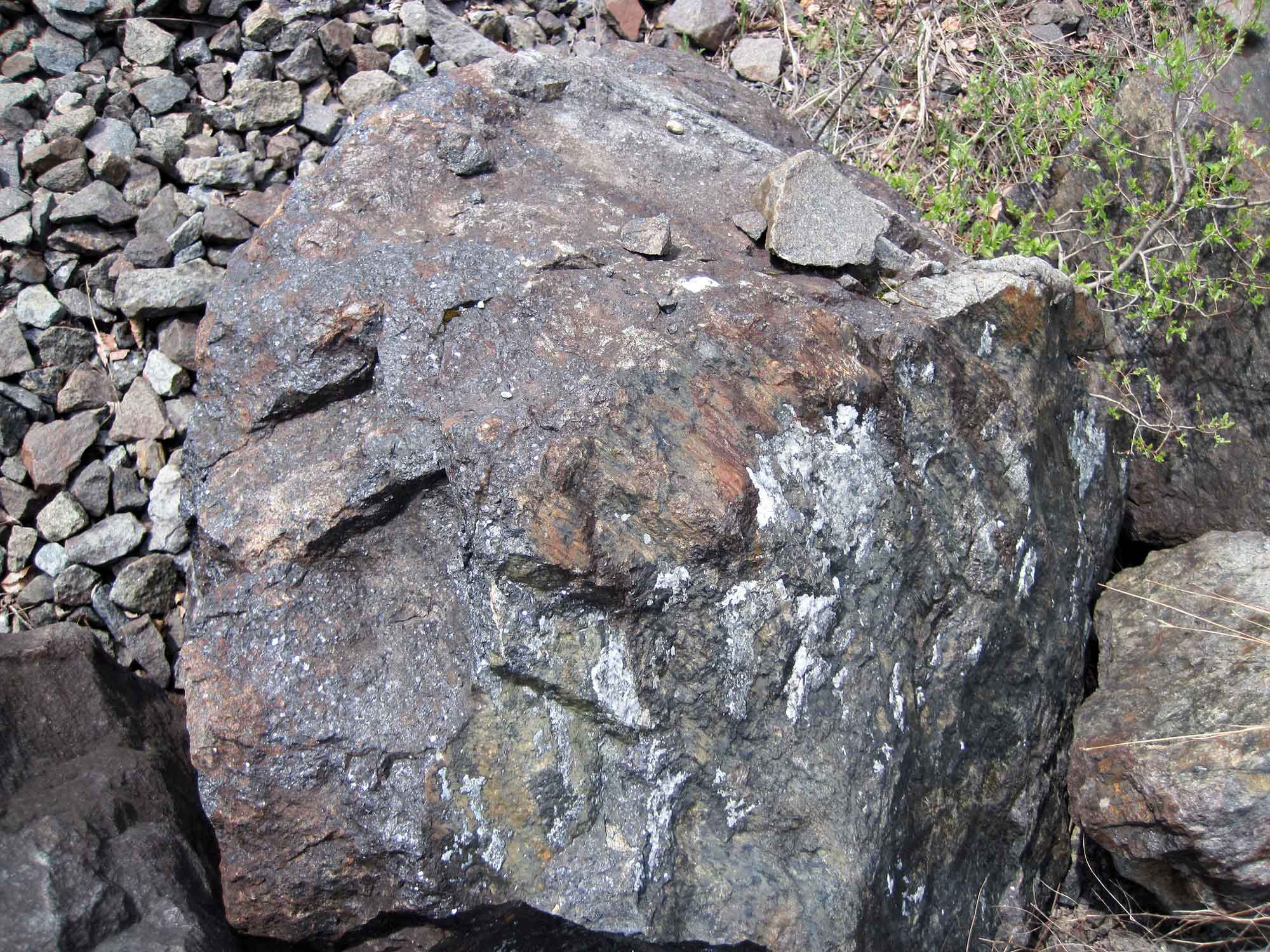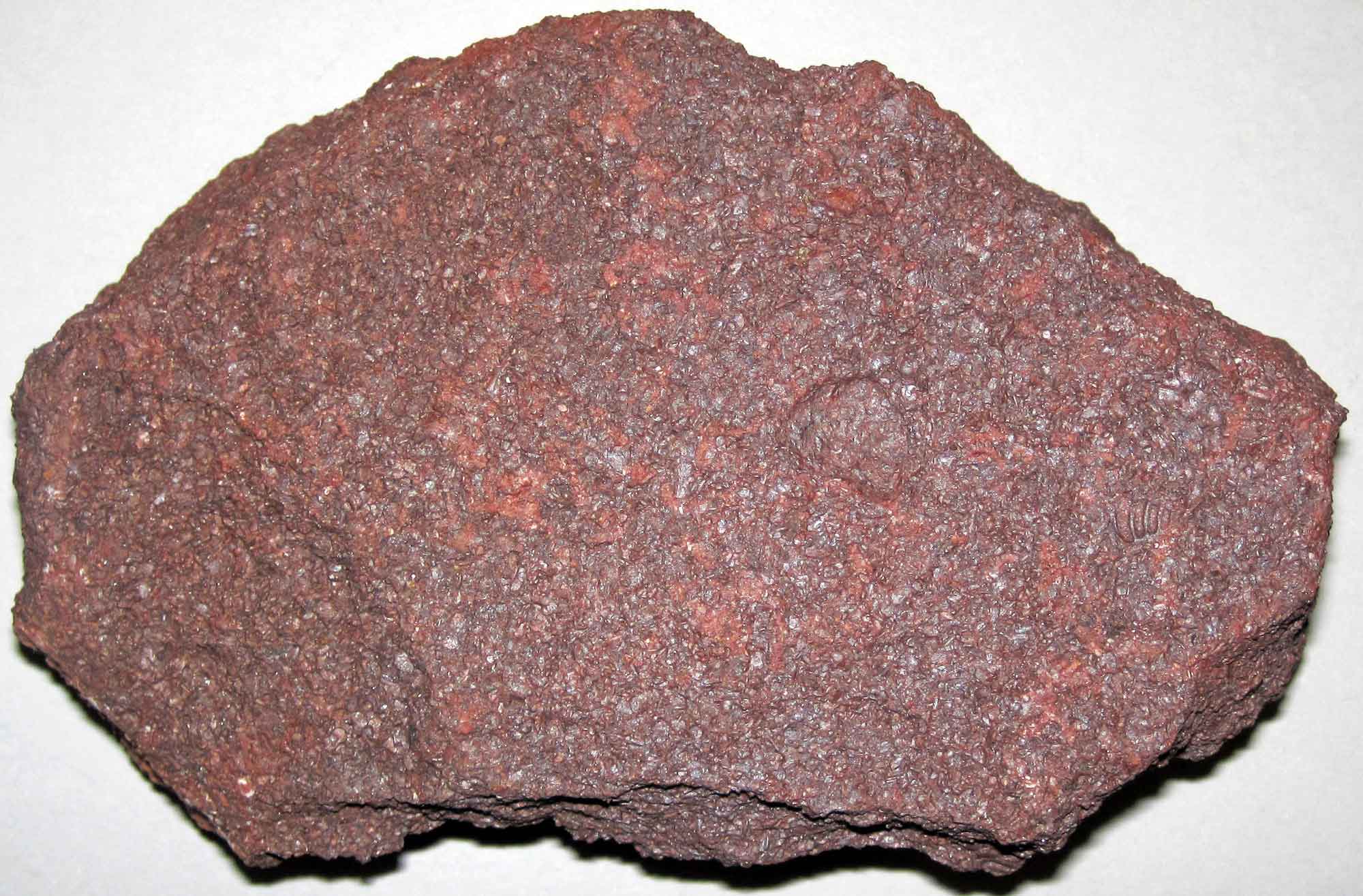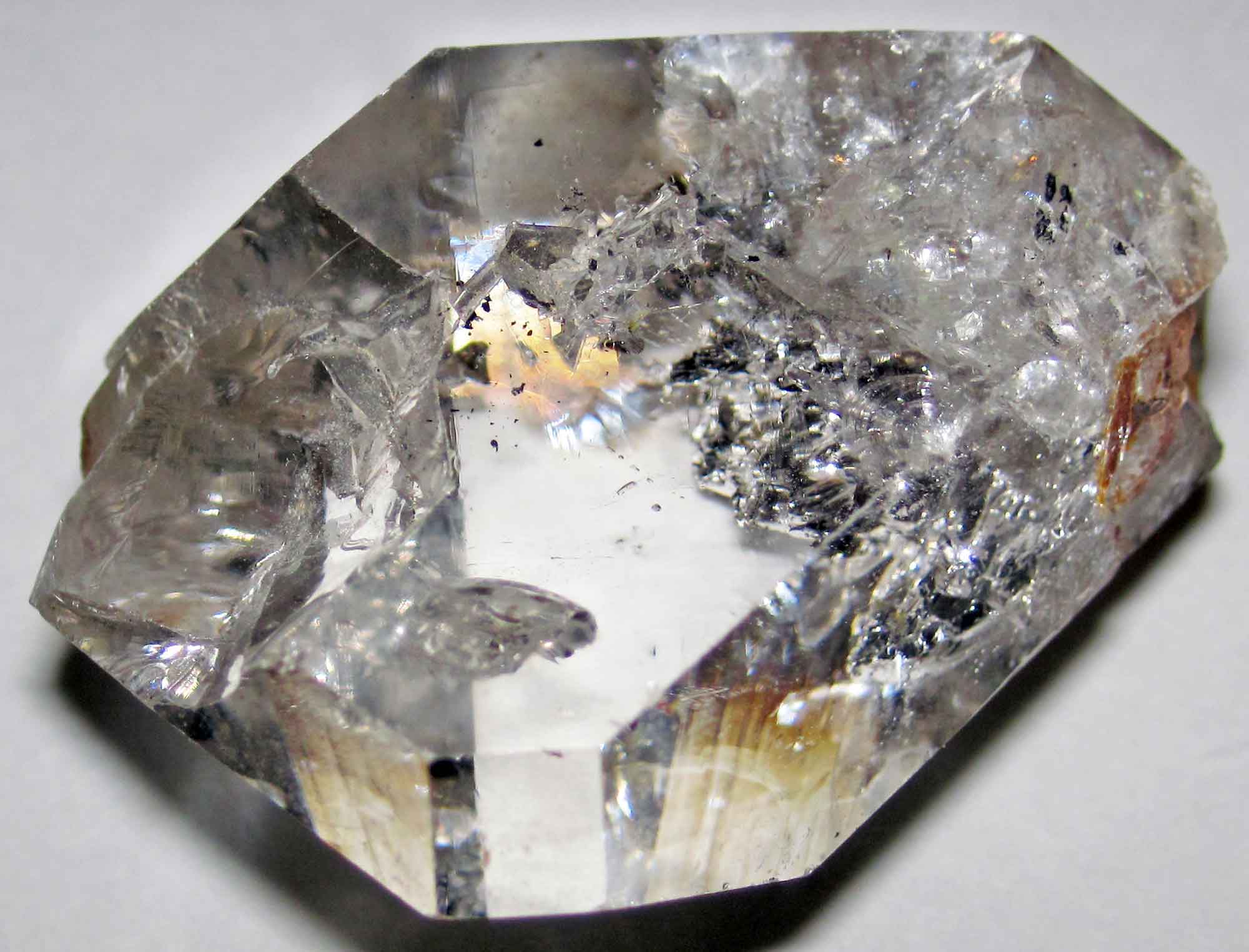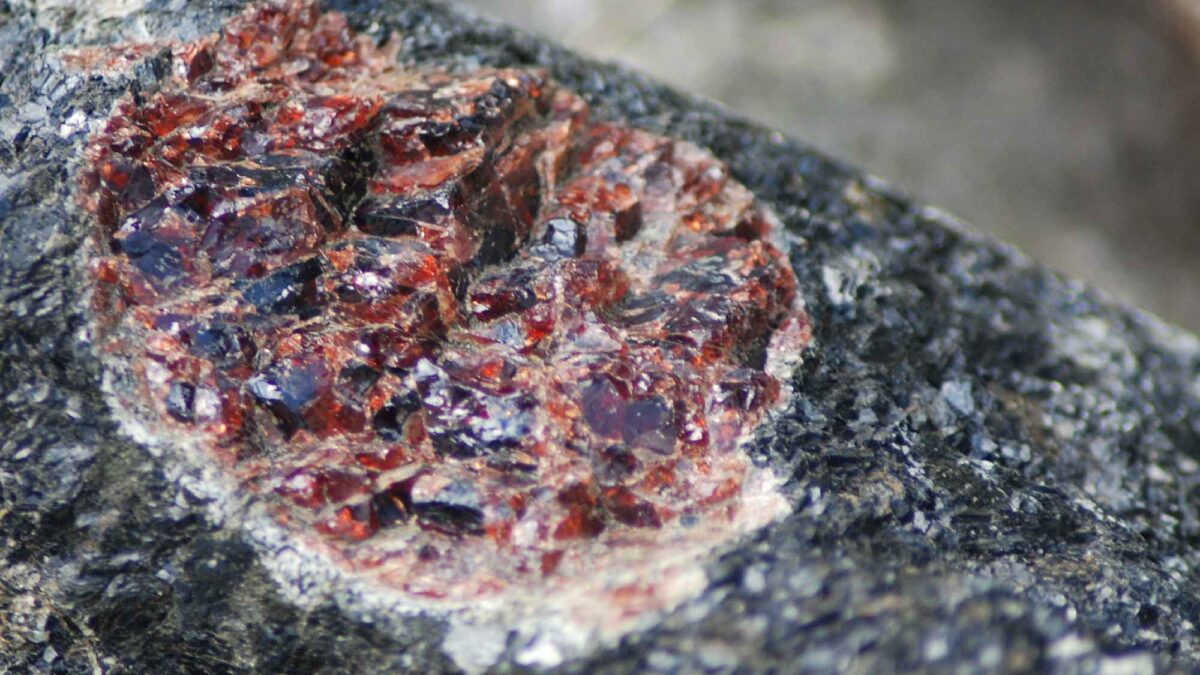Snapshot: Overview of the mineral resources of the Central Lowland and Inland Basin regions of the northeastern United States.
Topics covered on this page: Overview; Metallic Resources; Non-Metallic Resources; Resources.
Credits: Most of the text of this page is derived from "Mineral resources of the Northeastern US" by Jane E. Ansley, chapter 6 in The Teacher-Friendly Guide to the Geology of the Northeastern U.S. (published in 2000 by the Paleontological Research Institution). The book was adapted for the web by Andrielle Swaby, Elizabeth J. Hermsen, and Jonathan R. Hendricks. Changes include formatting and revisions to the text and images. Credits for individual images are given in figure captions.
Updates: Page last updated October 3, 2023.
Image above: A large garnet from Gore Mountain in New York State. Photograph by BobMacInnes (Flickr; Creative Commons Attribution 2.0 Generic license).

Overview
The Inland Basin is rich in a variety of minerals, though only a few are mined commercially. The sedimentary rocks, making up the thick sequences of the Queenston and Catskill Deltas, formed from sediments eroded off of the Taconic and Acadian Mountains into the inland ocean during the Ordovician and Devonian. The Adirondacks, strikingly different from the surrounding sedimentary rock, are made of billion-year-old Grenville rocks.
Between the sedimentary rocks of the basin and the igneous and metamorphic rocks of the Adirondacks, there is a wide diversity in the principal mineral resources found in the region, including metallic minerals such as iron, zinc and illmenite, and non-metallic minerals such as gypsum and salt.
Metallic resources
Grenville rocks
The Precambrian Grenville rocks of the Adirondacks, formed as the Grenville marine sediments were compressed and tacked on to North America, are seen poking through the younger sedimentary rock cover in the Adirondack region of New York. The Grenville rocks include metamorphosed sedimentary rocks such as marble, gneiss, and quartzite, as well as anorthosite, an igneous rock crystallized from asthenosphere magma. With a mineral assemblage unique in the Inland Basin, the Adirondacks produce most of the metallic minerals in the region. The principal metallic mineral resources of the Adirondacks include iron, zinc, lead, silver, aluminum and titanium.
Iron in the Adirondacks is mined from the ore magnetite. Though geologists disagree on the origin of the iron, it may possibly have formed as deposits of iron in sedimentary rock that were later metamorphosed, or from concentration and later precipitation of magnetite crystals by hydrothermal solutions. Though iron may also be mined from other minerals, including hematite and siderite, and was at one time or another mined from every state in the Northeast, the only profitable site currently being mined for iron is in the Adirondack Precambrian gneiss.
Zinc, lead, and silver are often found in association with each other. Sphalerite is the most important ore mineral of zinc; galena is nearly the only regional source for obtaining lead; and silver is found in small amounts with galena. Both sphalerite and galena are found in commercial quantities in the Adirondacks. The minerals were initially concentrated by hydrothermal solutions and recrystalized through metamorphism when the Grenville sediments were compressed a billion years ago.
Until recently, illmenite was mined in the northeastern section of the Adirondacks where anorthosite rocks are found.

Precambrian (Mesoproterozoic) rock containing magnetite and ilmenite from a mine in the Adirondacks. Photograph by James St. John (Flickr; Creative Commons Attribution 2.0 Generic license).
Illmenite is an ore of titanium and was produced for use as a white pigment in paint. Titanium is also an important metal because of its lightweight nature, strength, and resistance to corrosion. As the Grenville rocks were compressed and metamorphosed, magma from the asthenosphere welled up through overlying rocks. The magma crystallized to form the igneous rock, anorthosite. Crystallization, however, did not happen all at one time. In a process known as crystal settling, the dense, heavy minerals crystallized first and sank to the bottom. Illmenite, being a heavier mineral, became concentrated at the bottom of the crystallizing magma to form the large deposits of the ore that we see today.
Aluminum is also mined in the northernmost part of the Inland Basin. Aluminum is a common component of high-grade metamorphic minerals such as kyanite, sillimanite and andalusite.
Other rocks
Iron is also found in Pennsylvania and other parts of New York besides the Adirondacks. In particular, layers of limestone in the Clinton Group of rocks, located in the Silurian deposits at the edge of the Appalachian Plateau, contain deposits of hematite and siderite. These iron-rich layers stretch as far south as Alabama and are important indicators of sea level rise and fall. Hematite forms in shallow ocean water and siderite forms in relatively deeper water.

Hematite (oolitic) from the Clinton Group of Wayne County, New York. Photograph by James St. John (Flickr; Creative Commons Attribution 2.0 Generic license).
Non-metallic resources
The Inland Basin also has a diverse assemblage of non-metallic minerals, from the wollastonite, garnet, tourmaline, and beryl of the Adirondacks to the salt and gypsum of the sedimentary rocks further south.
Grenville rocks
The mineral wollastonite is currently mined in the Adirondacks in Lewis and Essex County, New York.

Sample of wollastonite from Lewis County, New York. Photograph by James St. John (Flickr; Creative Commons Attribution 2.0 Generic license).
Wollastonite formed in the Adirondacks when the Grenville limestone was metamorphosed and intruded by magma. Ninety-nine percent of the wollastonite produced in the U.S. comes from New York.
The Adirondacks have also been a leading producer of garnets. Spectacular crystals, as large as 1 m across (though typically 2-2.5 cm across) have been found at the famous Gore Mountain garnet mine.

Amphibolite containing large garnets rom Gore Mountain in the Adirondacks, Warren County, New York. Photograph by James St. John (Flickr; Creative Commons Attribution 2.0 Generic license).
Though the Gore Mountain mine is now closed, the mine at nearby Ruby Mountain continues to be a leading producer of industrial garnet for use as an abrasive. When the Grenville sediments were compressed and metamorphosed over a billion years ago, the heat and pressure melted the deeply buried rocks to magma. As the magma pushed up through the overlying Grenville marble, gneiss and quartzite, it gradually crystallized to form anorthosite and other igneous rocks. When these igneous rocks were also metamorphosed, the heat and pressure recrystalized some of the rock to form the famous garnets.
Evaporite rocks
The Inland Basin was part of an inland ocean for hundreds of millions of years as the continents pulled apart and pushed together. A shallow restricted sea is the ideal environment for the evaporation of water and deposition of evaporite minerals. Halite (salt) and gypsum are examples of evaporite minerals. The Silurian, in particular, was a time of especially shallow seas with poor circulation in the region. It makes sense, therefore, that salt and gypsum are both found in Silurian sedimentary rocks exposed across central New York. The salt is at the surface, as natural salt springs, around Syracuse, New York. The gentle tilt of the Silurian rocks to the south means that salt is also found and mined underground south of the exposed salt beds, buried beneath Devonian rocks.
"The real answer: Where our road salt comes from" by syracuse.com (YouTube).
Salt has played a key role in the economy of upstate New York, and was the reason for the founding of cities like Syracuse, NY. The Retsof Mine near Geneseo, NY was the largest underground salt mine in the world before its collapse in 1993.
Gemstones
In addition to the abundance of metals and non-metallic minerals produced for industrial use in the Adirondacks, the Grenville rocks also contain the minerals tourmaline and beryl, prized as gemstones. Further south in Herkimer County, New York, in a patch of Cambrian rocks southwest of the Adirondacks, gem collectors seek out "Herkimer diamonds."

A Herkimer diamond from Herkimer County, New York. Photograph by James St. John (Flickr; Creative Commons Attribution 2.0 Generic license).
Herkimer diamonds are not in fact diamonds at all. Rather, they are very well formed, clear crystals of quartz found in the Little Falls dolostone. Dolostone is made in part of calcite, a mineral that is highly susceptible to reacting chemically with acids. The weakly acidic nature of rainwater and groundwater commonly dissolve away parts of dolostone, leaving open cavities in the rock. As groundwater, rich in silica, moved through the Little Falls dolostone, quartz crystallized in the cavities to form Herkimer diamonds.
Resources
Resources from the Paleontological Research Institution
Digital Atlas of Ancient Life: Minerals (collection of 3D models on Sketchfab): https://skfb.ly/6WxTo
Digital Encyclopedia of Earth Science: Minerals: https://earthathome.org/de/minerals/



